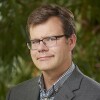SLAC X-ray Laser Facility Completes Major Upgrade

Aerial photo of the cryoplant of the Linac Coherent Light Source, which just completed a major upgrade.
(Matt Beardsley / SLAC National Accelerator Lab)
The $1.1 billion Linac Coherent Light Source II project at SLAC National Accelerator Lab passed its “first light” milestone
Like synchrotron X-ray sources, XFELs are used to probe molecular and atomic structures but offer far brighter beams as well as ultrashort pulses that enable superior time resolution for studying dynamic phenomena. SLAC introduced the world’s first XFEL when it opened LCLS in 2009, and the upgrade adds a second X-ray laser employing 37 superconducting electron accelerator modules that are cooled to near absolute zero.
The new laser is 10,000 times brighter than the original and has a pulse repetition rate 8,000 times faster, reaching a record-smashing one million flashes per second.
Work has already started on another upgrade,


